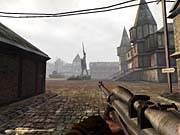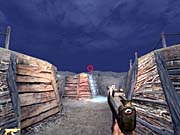Have you ever wondered what the 1960s would have been like had World War I never ended? Probably not. Yet here's Iron Storm, a first- and third-person shooter that attempts to answer the question no one asked. Its story doesn't make a whole lot of sense, and it's sometimes frustratingly difficult, but Iron Storm is a reasonably successful action game, which is what counts.

The game takes place in Germany during 1964, which is apparently the 50th year of the ongoing first World War. And even if you're not interested in WWI, you'll feel right at home with the game, because the advanced technology and modern fantasy weapons available to you give the whole undertaking an atmosphere not too different from that of any other generic shooter. The only real references to the Great War are the occasional mustard gas grenade and the fact that about a third of the game's levels are set in trenches--somewhat improbably, since much of the equipment on display in the game (such as portable communication devices, modern tanks, and advanced artillery) are all technical innovations that made trench warfare obsolete. You might as well just pretend it's a slightly off-kilter World War II game or a bizarre version of the Vietnam War fought against Germans in Western Europe.
Iron Storm's gameplay is a cross between a straightforward shooter and an adventure game. Though there's a lot of gunplay, the game also has a fair number of puzzles to solve. In fact, the game's six levels are for the most part nonlinear, often requiring you to visit certain sections repeatedly and sometimes offering multiple ways for you to complete your objectives. The puzzles are generally environmental and often involve figuring out what needs to manipulated or blown up in order to proceed. Your goals--given to you via earpiece radio by an operative back at home base--are often a little too sketchy, though computer terminals scattered around the levels provide some useful hints. The puzzle elements aren't overwhelmingly difficult, but they do slow the game down for anyone expecting an uninterrupted shooting spree. We did encounter a specific scripting bug on one level in which a door that should have opened didn't, forcing us to reload a saved game from the previous level and replay a large section of the game. If you run into the same problem, you may even become uncertain about whether an obstacle is a puzzle or just a bug later in the game, so it's a good idea to save early and save often, rather than rely on the game's quick-save feature.
Occasionally, Iron Storm requires you to use stealth. Some of these episodes are frustrating mainly because the game doesn't really have a stealth interface. Unlike in most games that require some stealth, there isn't any real incremental feedback built into the system. You basically go prone, crawl around, and hope for the best. One section in which you have to sneak through a prison camp is a maddening exercise in trial and error.
Though the game's stealth and puzzle elements are occasionally frustrating, Iron Storm's fighting is well done. The game has good enemy AI. Opponents utilize cover and know how to both throw and run away from grenades. They still sometimes exhibit traditional AI lapses, such as running in place after getting trapped on some piece of the environment and failing to react as their companions are mowed down, but for the most part, they're competent enough and pack enough of a wallop to be a real threat. The implementation of enemy snipers is handled really well. There are a lot of them (especially in the game's best level, which takes place in a half-destroyed city), and they're deadly, but they're not perfect shots. Since you can go prone and switch into a third-person perspective that gives you a much more panoramic view of your surroundings, sniper battles turn into an interesting cat-and-mouse game of finding and utilizing cover rather than an irritating exercise in saving and reloading.
Trenches aren't the most exciting environments, and unfortunately, Iron Storm's first two levels take place in them. The designers at 4X Studios deserve some credit for making them interesting at all. On the other hand, they might have simply decided not to use trenches to begin with. Luckily, after the trenches the levels get more interesting, both visually and in terms of gameplay. 4X Studios' custom engine powers the game's graphics, and it does a good job with both interiors and large outdoor areas. It's also capable of producing some attractive special effects, including one impressive scene in which the sky above a bombed-out street clouds over and then begins to pour rain. The game's character models aren't quite as good. They look fine in still screenshots, but they're stiffly animated and they often move in a floaty, unrealistic manner, almost as if they're filled with helium.

Iron Storm has four multiplayer modes. Along with the standard deathmatch, team deathmatch, and capture the flag modes, there's something called isolation case, which is basically capture the flag, but with only one flag. There's nothing wrong with Iron Storm's multiplayer features, but there's also absolutely nothing that sets them apart from the same features in pretty much every other shooter. There's also virtually nobody playing it at this point. Using the built-in server browser, we were never able to find more than three active servers.
Iron Storm's combination of challenging combat and puzzle elements set it apart from most run-and-gun shooters. It could have used quite a bit more polish, and it would have be more appealing as a budget-priced game, but for the 10 or 12 hours it takes to finish it, Iron Storm offers solid, if somewhat undistinguished, entertainment.